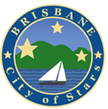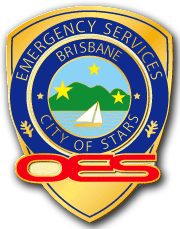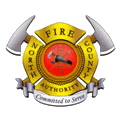Chapter 3a - War and Development
| Previous Segment | Next Segment |
>>>>>YOU'RE@ Chapter 3 -- "War and Development" -- Page 27>>>>>
WAR AND DEVELOPMENT: 1940-1961
"I came out here from Jacksonville, Florida. I got my discharge there from the service. My sister visited me down there. She's the one who told me about Brisbane. So, I came out here. I remember coming over that hill there. It was wintertime. It was raining, oh, it was raining. But this was the prettiest mountain and setting I think I ever saw. It didn't take me long to kind of fall in love with the place. I just been in Brisbane ever since."
-Frank Davis
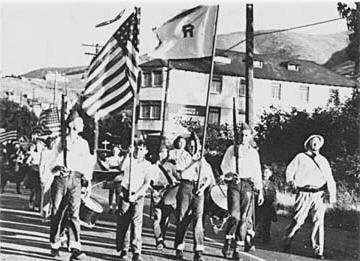
>>>>>YOU'RE@ Chapter 3 -- "War and Development" -- Page 29>>>>>
Brisbane Goes to War
"...more people here than before or since..."
As the American economy emerged from the doldrums of the Depression and geared up for the war effort, Brisbane enjoyed a renaissance of sorts. By 1940, the town had grown to nearly 2,500 inhabitants. It also had added a number of businesses. In 1941, Rene Poiret built the town's first theater. Other business developments from this time include: Phil Sphrilia's soda fountain, Joe Palladini's grocery store, Walter Gull's produce market, Dick Jonas's Tower Club and Brisbane Drug Company, John DeMarco's celebrated 23 Club, Tiny Burns's cleaners, George Hayward's Builder and Supply Service, Dick Schroeder's Brisbane Hardware Company, Mark Neadeva's Mill and Cabinet Works, and Chuck May's gas station and garage. In addition, Dr. S. J. Guardino, who became Brisbane's first resident physician in 1936, opened a new clinic on Mendocino Street. In the realm of town improvements, Brisbane residents voted to provide the necessary funds for the Pacific Gas and Electric Company to install new street lights. Under the direction of librarian Gertha McKinney, the citizens helped transfer the small public library from Jonas's Drug Store to a structure on Visitacion Avenue. Despite the town's unincorporated status, the people of Brisbane worked with various county, state, and federal agencies to improve its educational facilities, pavements, sewers, gas mains, electric lines, and telephone services. Brisbane also enjoyed something of an economic boom during the 1940s. The Brisbane Quarry expanded during the war years with workmen excavating huge

Looking out over Brisbane at the fleet in the Bay
>>>>YOU'RE@ Chapter 3 -- "War and Development" -- Page 30 >>>>>
quantities of rocks for the military home front projects. Operating 24 hours a day, the quarrymen employed new machinery and technology to maximize its war efforts. As a result, Brisbane Quarry products were in demand throughout the Bay Area. A number of people living in Brisbane found work in the surrounding shipyards. "During the war, everybody was working in the shipyards, including myself," recalls Dick Schroeder, a resident of Brisbane since 1938. "We had shipyards right down in South City and Bethlehem across the Bay. They were all over the place. We had a goodly amount of people at Hunter's Point. They worked in the repair yards for the Navy." "Brisbane was active, then, real active," summarizes Dorothy Radoff. "In fact, there were more people living in Brisbane than there's ever been before or since. At that time, our population got up to 5,000. Now, I believe, it's only 3,000. "There were so many more businesses here at that time. Things were altogether different. More bustling than it is now. Of course at that time, most women didn't work. People didn't have two cars. They were lucky if they had one. So the woman was car-less. She had to depend on local things mainly for her shopping. So you had a five and ten cent store. You had a bakery. At one time, there were two drugstores. You had about three markets on the main street."

"Brisbane lost some boys..."
One of the first residents of Brisbane to go off to war was a young man named Walter Blair. In the days before the United States officially entered the war, Blair volunteered to fly for England against the Luftwaffe. His plane was shot down and never recovered. His spirit was perpetuated by the creation of a special civilian defense unit: Blair's Rangers. To honor his lost son, L. D. "Sarge" Blair organized Blair's Rangers in the spring of 1942. The Rangers were a volunteer unit comprised of 30 to 40 boys and girls and First Class Ranger Tike, a springer spaniel. Ranging in age from 9 to 17, the Rangers were trained to patrol the San Bruno Mountains for possible saboteurs or parachutists. To join the Rangers, an applicant had only to be "husky enough to pack a nine pound rifle and full field equipment; own stout shoes; and have a decent pair of khakis and shirt for parade." Out of their own pockets, Sarge Blair and his wife paid for the food and other essentials to take the Rangers on their training excursions out into the woods.
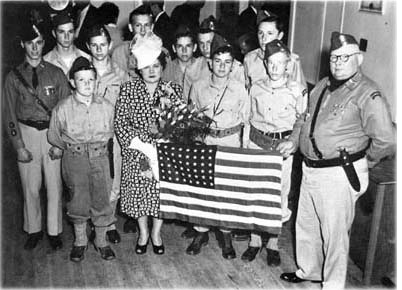
Sarge Blair expressed his mission as follows, "I want to bring home to the youngsters the realization of what it means to be an American and that anything worthwhile doesn't come easy." "Old Sarge was 100 percent military," relates John Gomez. "He would have his boys marching from his house right out of the entrance to Brisbane. He'd march them maybe down to the Bay and then they'd camp overnight or he'd be marching them up in the hills. They had rifles naturally with no bolts in them so nobody could get hurt and shoot themselves. But they were still packing a rifle, you know the M-l or the Springfields. Sarge was a good man and he really spent a lot of time with the boys in Brisbane."
The City of Stars
At the same time that Brisbane was gearing up for the war effort, its residents were also trying to improve the quality of life at home. It is from this period that one can trace one of Brisbane's oldest traditions, "The City of Stars." [Note: there are two versions as to what year and who started Brisbane's wooden star tradition. They are recounted below, with the paragraph in brackets not published in the original printing of the publication:]
In 1940, Arthur Kennedy began the tradition by placing a large lighted star on his home during the Christmas season. As the years passed, the idea caught on with the other residents of Brisbane. As they put up their stars, the town became transformed into a festive display of light for travelers coming down Highway 101 or Airport Boulevard. Soon, outsiders were calling Brisbane "America's Christmas Card Town." "Arthur Kennedy was a rather prominent man in town," explains Dorothy Radoff. "He was the president of the Chamber of Commerce and was very community minded. So, after he put up the first star, the Chamber of Commerce decided the next year that they would put up more stars. From what I understand, when they first started out, they made ten stars a year and they would distribute them to people who promised that they would put them up and take care of them.
[Former Brisbane Librarian and town historian Dolores Gomez, who conducted her own research of the issue using the old Brisbane Bee Newspaper, concluded afterwards: "Frank Walsh states, 'Mr. Gagnier, 328 Kings Road, put up the first Christmas star in 1938.' Mr. Gagnier lived way up on the hillside, so the star was a beacon that was seen all over Brisbane back then. In time, other r
esidents followed and put up stars on their homes for the Christmas season. By 1945, the Brisbane Chamber began sponsoring stars. My father, Richard Hosking, Frank Walsh and others helped to make more stars and distribute them to residents. Thus began 'THE CITY OF STARS."]Then every year, they kept adding more. That's how the stars started and we became known as the City of Stars. The terrain and all was just perfect for that sort of thing."
"The Second Barbary Coast..."
During this time, the town of Brisbane proved to be an irresistible draw to many a man in uniform. "We had an Army base at the very top of the hill," remembers John Gomez. "There was also Naval Bases at Hunter's Point and what they called Tanforan. So the Army boys, whenever they got leave from the mountain up there, they'd come down and hit the local clubs like the 23 Club and Dick's Tower. And then the Navy would come in. In those years, it was the Army and the Navy fighting against each other over the same girl." "It was like the Second Barbary Coast," recalls Mary Arcotti. "We used to have all the sailors from San Francisco in town. They gave it the name, the Second Barbary Coast. They meant that there was wine, women, and sailors. The town got pretty tough at times. A lot of fights. The sailors would come in and then try to get the girls. Then the boys here would try to fight back." When the war ended in 1945, it was time for the soldiers and sailors to take off their uniforms. In their return from the years of war, in their attempt to build a new life for themselves, Brisbane was to experience the next phase in its history.
A Second Wave
Home From the Wars
If the Great Depression brought a small group of pioneers to Brisbane, a second wave of immigrants came to the city following World War II. These were the men who had won the war and were now trying to build something out of the peace that followed. In the stories of such men as Jim Williams, Jess Salmon, Vince Marsili, and Frank Davis, one can see how this influx of new people into the area shaped the city's future course.
"I never knew I was going to live here..."
For Jim Williams, Brisbane represented a land of opportunity after a period of hard travelling. "I first learned about Brisbane in 1936," he recounts. "Of course, I never knew I was going to live there. I rode a freight train there from Los Angeles. Me and a friend, we left our home in Buffalo, New York, and went to Texas on a trip. We just wandered all around the country. My sister lived in San Francisco at the time, and that was our destination. "I was only 20 years old. We ran out of money in Los Angeles after staying in San Diego for a couple of days. Almost joined the Marines there. I came close, very close. If I had joined up then, I probably would have been in Guadalcanal when the war broke out. Anyway, we came up here and we jumped off the freight train in the freight yards in Brisbane. We walked up Geneva Avenue in Brisbane and took the street car down to San Francisco -- you know, right downtown.
"Then after the war, I got out of the Navy and I went back to San Bruno and bought a house there. You would never believe that we bought a house in San Bruno, a brand new house, for $2,500. That house is selling for $150,000 today. It's still there. Well, when I got out of the service, I had a few thousand dollars saved up. I saw an ad in the paper for a commercial place in Brisbane. That's where I started my body shop then, on Bayshore Boulevard. We bought it and that's how I came to Brisbane."
"I still didn't have a bedroom..."
Jess Salmon also came out of the service looking for a better life. "My father came to the Bay Area to work in the defense industry," he recalls. "So we came to Brisbane. I lived down here on Monterey Street in a chicken coop. I'm serious, it was a chicken coop. A little chicken coop in the back yard. Finally, my family found a home in South San Francisco on Grand Avenue. "I then got a job working for the Swift & Company meat packing plant. I was going to quit high school and work. I wanted that money, man. The money was good. The boss found out though that I hadn't finished high school and he fired me so I'd go back to school. He said, 'You're fired. But if you go back to school, I'll give you a night job.' So he gave me a nighttime job and I worked nights and I made $39 a week. That was good money in 1942. Then, the last semester of high school, I went half a day to school and worked from 1:00 P.M. to midnight, every night. "After high school, I went into the service. I came back in 1946. My parents were still living in the same house in South San Francisco. But they soon got an eviction notice because the owner wanted the building for something else. "My parents had no place to go. So I gave them my GI loan and my father bought a house. I still didn't have a bedroom. I never had a bedroom all my life until I got married. I got married in August of 1946.... My mother-in-law gave me a vacant lot in Brisbane as a wedding present. I built my home on it from my crap shooting money in the Army. I used to win at craps and then lose my shirt at poker. But I built my house and I raised four kids in Brisbane. I put all four kids and my wife and myself through college while working full-time. I put it all together and even ended up getting elected to City Council. So that kind of established me here and I just stayed. In 1967, I thought about moving to Marin County. But my wife said she'd divorce me before she'd move."
"You just don't drive a bulldozer up Main Street..."
For Vince Marsili, Brisbane represented a good job and a place to settle down. "I was born in San Gregorio, California in 1925," he recalls. "I grew up there picking artichokes and sprouts. Families were all farmers. We moved to Rockaway Beach when I was eight. I grew up there in the artichoke fields. We then moved to Daly City. I worked there as a scavenger, a truck driver, and in the lettuce fields. Finally, I went into the service. "When I came out of the service in 1945, I went to work for the Crocker Land Company, which is adjacent to Brisbane right now. At that time, it was in county territory. There was nothing there. It was a total of 3,500 acres of undeveloped land which was populated mostly by cattle. It was dairy cattle, not domestic. "I spent most of my years down there, working under the Crocker Land Company, coming up through the ranks, and being the only resident on the Crocker Estate. I guess my biggest thing was that when the cattle were there, they presented a big problem to Brisbane. Cattle would just get out of the fences and all of a sudden you'd have a bunch of cows down Main Street.
"My main job was to keep the road open going to the TV towers, which is the road that entered Crocker Avenue in Daly City, an old wagon road way back in Spaniard days. It was partially paved going up there, but every winter the trees would fall down and block the road and the radio towers couldn't get in to broadcast. So those were my main functions up there: to keep the road open and to make sure that the cattle stayed where they belonged.
"So I had control of Crocker Park. I had barns up there and everything. I had machinery that was not accessible to anyone else at the time. I guess that's why I fitted in so well. I was there if anyone needed a dump truck or something or a load of sand. I recall one time before Brisbane was a city. It was still under the county's jurisdiction. The county used to come up and want to borrow my bulldozer all the time. One year when the Trinity Road slid down, nobody could get by and their grader went off the road. I had to go up there and help them. I had no way of getting there except I had this bulldozer and I said, 'Well, everything is blocked the other way and I can't get up that way. How am I going to get there?' And they said, 'Just walk it up Main Street.' "Well," I said, 'that will tear up the asphalt. They said, 'We'll patch it. Don't worry about it.'
"And that's what we did. I moved the bulldozer up Main Street, drove up there, and got their grader off. They said, 'While you're here, you might as well push all the mud off too.' So I did. After I got through, I walked it back down Main Street and back up the valley. "Here I am 61 years old and still going strong. I don't think though that you can bring those memories to reality any more now. Those things we've done in the past 30 years you could not do now. You just don't drive a bulldozer up the main street. You just can't put on a show like you did then because people now will not let it happen -- even though people would like to see those things still."
"It didn't take me long to kind of fall in love with the place."
For Frank Davis, Brisbane almost seemed like the proverbial pot of gold at the end of the rainbow. "I was born in Barto County, Georgia. I grew up in Atlanta, Birmingham, Houston, Atlanta again, and Jacksonville. I came out here from Jacksonville, Florida. I got my discharge there from the service. My sister visited me down there. She's the one who told me about Brisbane. So, I came out here. I remember coming over that hill there. It was wintertime. It was raining, oh, it was raining. But this was the prettiest mountain and setting I think I ever saw. So it didn't take me long to kind of fall in love with the place. I just been in Brisbane ever since. "When I came here, you didn't have all the businesses and the houses. The recreation hall was down here in the flat right across from the motel. There was a little lake in front of it. Set it off beautiful. All this out here where Crocker's at was pastureland. A little creek running through it and all. Kids used to go down there and catch tadpoles. It was beautiful. "To go back, it was as hard to find a place to live in Brisbane then as it is now. Then I met a Mr. Arthur. He was building a new house over here on Alvarado. In the meantime, he was living in a 27-foot trailer. So me and my wife and kid got one of them little motel rooms until his house was finished. Then I bought the trailer and we lived there for a long time. "I bought this little restaurant. Pretty small -- I used to feed people in the back room, in the store room. You know bar nights when the bar would close, I'd fill up. I am pretty famous for my fried chicken and hamburgers. I pan-fried my chicken then, you know. I still got the reputation around here.
>>>>>YOU'RE@ Chapter 3 -- "War and Development" -- Page 35>>>>>
"There were two fellows in the hardware store at the time, Charlie Dixon and Dick Schroeder. Dick's still around. Charlie left and Dick took over the hardware store. He run it for years. There was also this fellow, John DeMarco. I guess he's one of the first I ever met here. "He was also one of the best first people I met when I came here. We got to be pretty good friends. John did a lot for Brisbane. Of course, since he run a bar, there's a lot of people who didn't understand that. But I was right there. I had the restaurant right next door so I knew what was going on. John really helped this little town out a whole lot. Even after it became a city. He was all out for any charity occasion that'd come along, things like that. And if a friend needed $50, $100, it was Johnny, you know. He done different things for the community. He's the one that started out trying to get a swimming pool. "John also brought us entertainment we hadn't been used to. Like Johnny Cash and Webb Pierce, Bob Wills, Hank Snow and different ones. It got to be a pretty lively town on Friday and Saturday night. People worked hard here, but when the weekend came around, they played hard too. The 23 Club had a big dance floor and every weekend it was crowded. I moved my little restaurant right next door to it, with the runway from the dance floor of the 23 Club into the restaurant. It was built that way to make it convenient for people in the bar to go through there and have a bite to eat.

"I also had a drive-in across the highway. You know the Bayshore used to be the main highway through here when I came here. Your freeway was probably just a dream then. There was a main highway and there was a big all-night filling station and truck stop across there. They had bunks and all and showers for the truck drivers. It was a 24-hour business, so I had the "Chicken Basket" there, as we called it. All my customers from town came over there as well as the truck drivers. So all in all it was a pretty busy place. "Yes, I came out here first in 1946. It hasn't been quite 40 years. It was in early '46. I don't know. I just fell in love with the place. I guess I just got to be part of it. Knew everybody at that time and this place was always good weather. If there was nice weather, we had it. The fog never got down in the city. It always stayed up on the mountain. Slept under the same covers all year long..."
The First "Western Days"
"Brisbane has always been considered a Western town..."
As Frank Davis puts it, Brisbane in the late '40s and early '50s was a town that liked to "work hard and play hard too." As the '40s gave way to a new decade, the people of Brisbane had good reason to celebrate their accomplishments. The town was successfully assimilating a new wave of Americans back from the war. These men and women were busy building businesses, raising families, and getting about the business of finding the good life after the hard times of Depression and war. By 1950, Brisbane was well on its way to becoming a modern town. It could boast of a number of diverse organizations and services. These included a movie theater, a small retail district, a Y.M.C.A., the Brisbane Homeowner's Association, the American Legion and Auxiliary, the Veterans of Foreign Wars, the Lions Club, the Witts Club, the Brisbane Garden Club, the Vellums, and the Circle 8 Square Dance Group. Many Brisbane residents felt it was time to celebrate the town's accomplishments and future promise. They found a way to do this in a unique public celebration of their heritage and hopes. They called it "Western Days." "Brisbane has always been considered to be like a Western town," relates John Gomez. "A lot of people here had horses. Every now and again, they'd have a parade and the horses would be tied up to bumpers on vehicles and bars and so forth. Parades were always great in Brisbane. They always had parades around the Fourth of July and different celebrations and so forth. I believe it may have been the Chamber of Commerce that said, 'Hey, let's have Western Days."' If John Gomez is uncertain about the exact origin of Western Days, there are a number of fascinating stories behind the evolution of this unique festival.
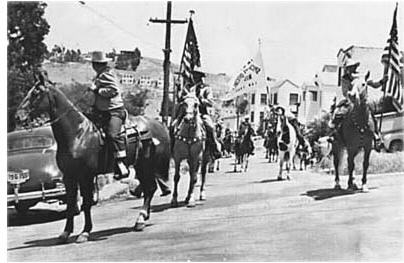
Western Days--1950s
>>>>>YOU'RE@ Chapter 3 -- "War and Development" -- Page 37>>>>>

"I said we've got to make some money..."
For Jim Williams, Western Days was a result of a clear-cut need. "I was president in 1949 and 1950 of the Lions Club," he recalls. "In those days, gambling was big in Brisbane. There were slot machines. There were all kinds of gambling games. After all, Brisbane was a long way from the county government. So, it wasn't that gambling was legal. It was just overlooked. "At any rate, I got the idea for these Western Days. I said we've got to make some money. We didn't have any money in the Lions Club at all. I thought, 'We'll bring the people into town and then get the money off them. We'll put up some stalls and sell them food and let them play slot machines and beat the dealer and do a lot of gambling games.' "Dick Schroeder knew the sheriff at the time. Dick said, 'Let's go see the sheriff.' We went down and saw the sheriff and told him exactly what we were going to do with the slot machines and all that stuff. Well, we went right to his home and he was in his bathrobe and everything. A big guy. He was really a huge guy. He said, 'Well, Jim, I didn't hear a thing about it. I don't even know what's going on. I'm not coming down. So you do what you want.' I told him we wanted it for charity and things of that nature. And that is what we did it for. "We came up with the theme of Western Days from the sense of Brisbane being a western town. In those days, we didn't have any sidewalks. Just a little old main street with a strip of pavement down the middle. So it was Western. "Anyway, that's where it started. And that first one was a good one. Everybody was dressed up. We had on beards and cowboy outfits. We even had a donkey baseball game. We played baseball on a donkey. I would get off and hit the ball and then jump on the donkey and run to first base. But sometimes the donkey wouldn't want to go that way. Once, I jumped on the donkey and fell clear down on the other side. I'll never forget that a couple of guys rode the donkeys right into the 23 Club.
"That first year we cleared $1,900 in a week. That was a lot of money for our club. Particularly in the 1950s. So we were rich. The next year, I was out and Cliff Mozzetti was the club president. They put it on again. Well, the sheriff had died in the meantime. So there was a new sheriff. Well, they had these gambling games and they thought, 'It's the same thing as last year.' But they didn't go and see nobody. "One night, all of a sudden, the sheriff's cars just came around and took all the Lions members off to Redwood City. Just arrested them! It happened! They were in jail down there quite a while until they finally straightened it out and knew that these guys are alright people, that they were just doing it for charity. They let them go after four or five hours."
"In those days, you kind of made everybody's house your own..."
For Vicki Hobson and Mary Golden, Western Days was simply a continuation of a number of Brisbane activities. As young girls who came to Brisbane in the late 1940s, they recall how the celebration evolved. "When it first started, it wasn't a club function," relates Vicki Hobson. "It was a city function. They started with these barbecues at the 23 Club, a long, long time ago. And then the Lions Club picked up on the barbecues. They used to have a barbecue almost every month, or every two months, and it was a different kind of dress. One was the Roaring Twenties, the Gay '90s, Mexican, Hawaiian, and everybody used to dress the part. And then it started the Western Days." For both women, Western Days was part of a larger community spirit in Brisbane, an atmosphere where people joined together to entertain themselves. "We didn't have the fast food or video places in those days," recalls Mary Golden. "But we did have Friday Night Dances in grammar school. We also had a Teen Center. We always had ping-pong and all sorts of activities."

The 1950 Christmas Parade sponsored by the
>>>>>YOU'RE@ Chapter 3 -- "War and Development" -- Page 39 >>>>>
"You could dance in the Teen Center," continues Vicki Hobson. "They had music there. They had an old jukebox. Everybody in town would go. My parents rented it for my sixteenth birthday party. All the kids hung crepe paper and we danced and ate cake. "We also used to get together at the Brisbane Theater. They had an Amateur Night on Saturdays. We would get up there and either pantomine or jitterbug. We thought we were pretty hot there in front of a whole audience. It was like an old family theater. You'd get up on stage before the movie started. Everybody could do whatever they wanted. You'd win a prize and then see the movie." "That was in 1953," explains Mary Golden. "It was great having a theater. Such a convenience. The kids now they have to get on a bus or drive somewhere. But just having the theater here was so nice. It gave us something to do and kept us off the streets. We also would go to the Fountain. It was a great place to hang out. You could get a big basket of french fries and a Coke. It was a place where you felt relaxed and welcome and you could play music." "We never had any of the kinds of problems that kids do now," concludes Vicki Hobson. "No violence, or any of that. No crime. In those days, you kind of made everybody's home your own. Nobody was better off than anyone else. We were all the same. We used to switch sweaters, switch clothes. None of us had a wardrobe that amounted to anything. It was the same with everybody that lived in town. All the kids were the same. There wasn't a family that had more money than we did."
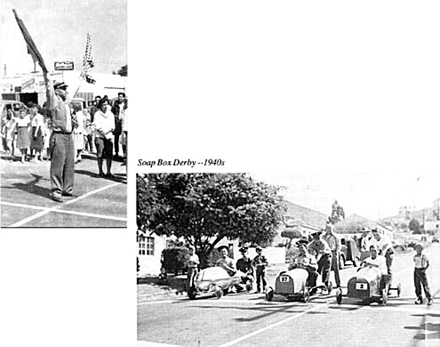
Whatever the exact origin of Western Days, then, it certainly sprang from a long-time tradition in Brisbane of self-help and neighborly feeling. Still, the festival only briefly flourished in the 1950s. It was discontinued after a few years as a result of too many public disturbances. But, it was too good an idea to simply die. As Brisbane matured as a community, people would attempt to resurrect Western Days for a second try.
| Previous Segment | Next Segment |

